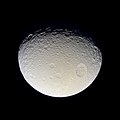Fichier:Tethys cassini.jpg

Taille de cet aperçu : 600 × 600 pixels. Autres résolutions : 240 × 240 pixels | 480 × 480 pixels | 1 000 × 1 000 pixels.
Fichier d’origine (1 000 × 1 000 pixels, taille du fichier : 368 kio, type MIME : image/jpeg)
Historique du fichier
Cliquer sur une date et heure pour voir le fichier tel qu'il était à ce moment-là.
| Date et heure | Vignette | Dimensions | Utilisateur | Commentaire | |
|---|---|---|---|---|---|
| actuel | 12 décembre 2018 à 20:17 |  | 1 000 × 1 000 (368 kio) | Kesäperuna | 100% JPEG quality from full quality TIFF. |
| 6 mai 2015 à 10:19 |  | 1 000 × 1 000 (68 kio) | Jcpag2012 | Reverted to version as of 05:22, 31 January 2005 | |
| 20 mars 2015 à 11:12 |  | 746 × 680 (60 kio) | Jcpag2012 | Cropped 25 % horizontally and 32 % vertically using CropTool with lossless mode. | |
| 31 janvier 2005 à 07:22 |  | 1 000 × 1 000 (68 kio) | Bricktop | ||
| 29 novembre 2004 à 15:31 |  | 600 × 538 (47 kio) | Wricardoh~commonswiki | Thethys (satellite of Saturn) imaged by the Cassini spacecraft. |
Utilisation du fichier
La page suivante utilise ce fichier :
Usage global du fichier
Les autres wikis suivants utilisent ce fichier :
- Utilisation sur af.wikipedia.org
- Utilisation sur ast.wikipedia.org
- Utilisation sur be.wikipedia.org
- Utilisation sur bg.wikipedia.org
- Utilisation sur bn.wikibooks.org
- Utilisation sur bs.wikipedia.org
- Utilisation sur cs.wikipedia.org
- Utilisation sur da.wikipedia.org
- Utilisation sur de.wikipedia.org
- Utilisation sur de.wikibooks.org
- Utilisation sur el.wikipedia.org
- Utilisation sur en.wikipedia.org
- Utilisation sur en.wikibooks.org
- Utilisation sur en.wikisource.org
- Utilisation sur eo.wikipedia.org
- Utilisation sur es.wikipedia.org
- Utilisation sur fi.wikipedia.org
- Utilisation sur gn.wikipedia.org
- Utilisation sur hr.wikipedia.org
- Utilisation sur hy.wikipedia.org
- Utilisation sur it.wikipedia.org
- Utilisation sur ja.wikipedia.org
- Utilisation sur ja.wikibooks.org
- Utilisation sur ka.wikipedia.org
- Utilisation sur ko.wikipedia.org
- Utilisation sur la.wikipedia.org
- Utilisation sur lt.wikipedia.org
- Utilisation sur lv.wikipedia.org
- Utilisation sur ml.wikipedia.org
- Utilisation sur ms.wikipedia.org
- Utilisation sur mwl.wikipedia.org
- Utilisation sur nl.wikipedia.org
- Utilisation sur nn.wikipedia.org
- Utilisation sur no.wikipedia.org
Voir davantage sur l’utilisation globale de ce fichier.

